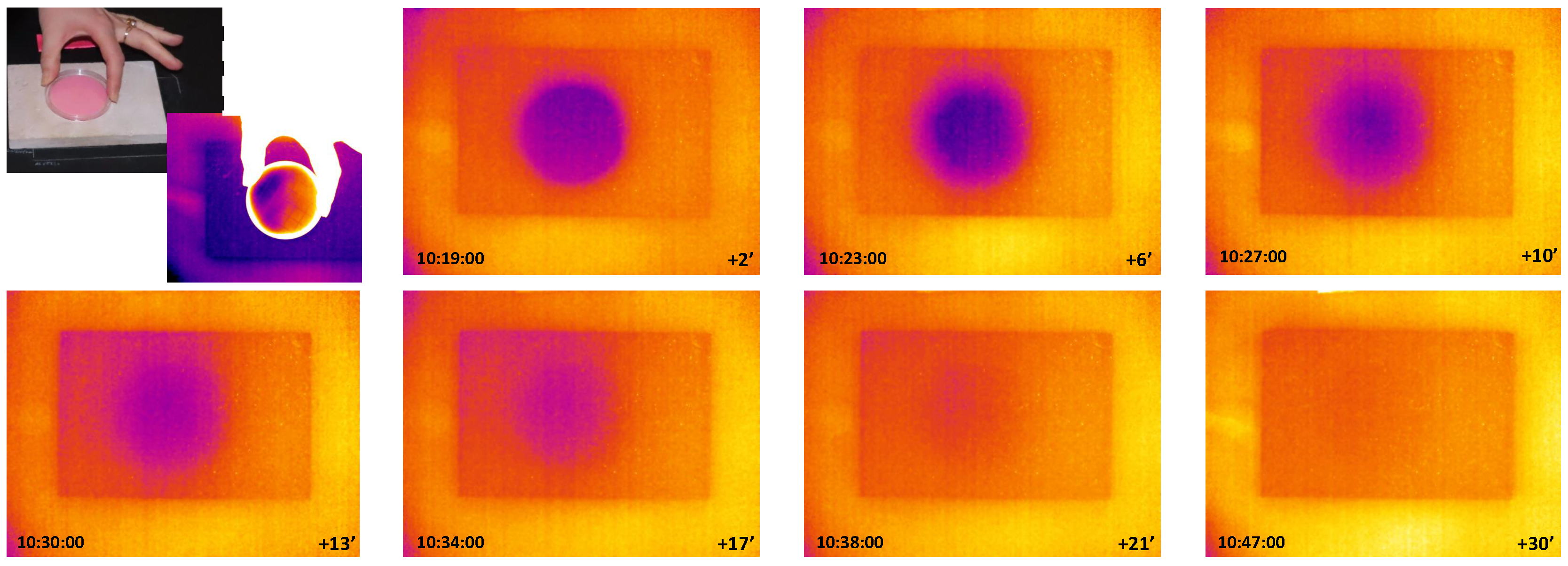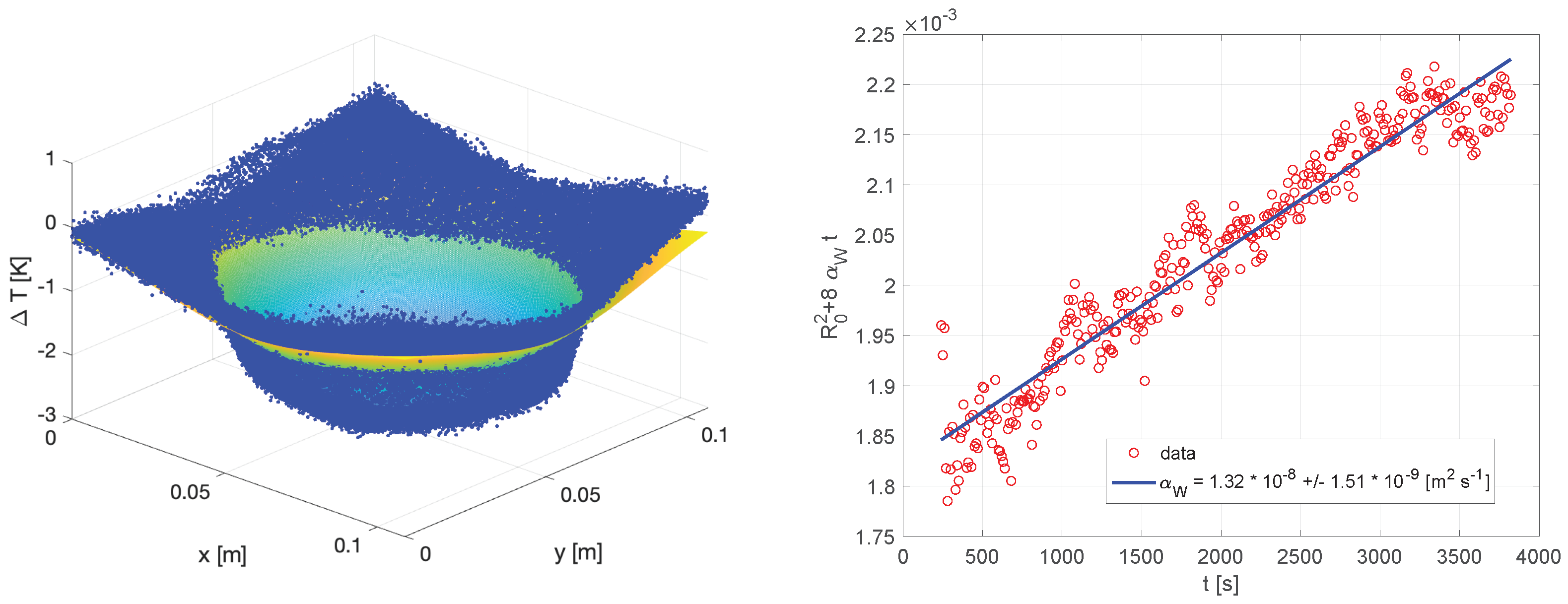Monitoring Moisture Diffusion after Contact Sponge Application †
Abstract
:1. Introduction
2. Modeling
3. Results
4. Conclusions
Author Contributions
Funding
Institutional Review Board Statement
Informed Consent Statement
Data Availability Statement
Conflicts of Interest
References
- Marshall, S.J. Detecting moisture in buildings using infrared thermography. In Thermal Infrared Sensing Applied to Energy Conservation in Building Envelopes: Thermosense III; Proc. SPIE 0254; SPIE: Bellingham, WA, USA, 1980. [Google Scholar] [CrossRef]
- Lyberg, M.D.; Mattsson, M.; Sundberg, J. Detection of moisture damage in buildings using thermography. In Thermosense XII: An International Conference on Thermal Sensing and Imaging Diagnostic Applications; Proc. SPIE 1313; SPIE: Bellingham, WA, USA, 1990. [Google Scholar] [CrossRef]
- Grinzato, E.; Ludwig, N.; Cadelano, G.; Bertucci, M.; Gargano, M.; Bison, P. Infrared thermography for moisture detection: A laboratory study and in-situ test. Mater. Eval. 2011, 69, 97–104. [Google Scholar]
- Bison, P.; Cadelano, G.; Capineri, L.; Capitani, D.; Casellato, U.; Faroldi, P.; Grinzato, E.; Ludwig, N.; Olmi, R.; Priori, S.; et al. Limits and advantages of different techniques for testing moisture content in masonry. Mater. Eval. 2011, 69, 111–116. [Google Scholar]
- Baggio, P.; Bison, P.G.; Bonacina, C.; Bressan, C.; Grinzato, E. Thermal inertia evaluation in porous material by multispectral optical analysis. In Proceedings of the XVIII I.I.R. International Congress, Montreal, QC, Canada, 10–17 August 1991; pp. 694–698. [Google Scholar]
- Bison, P.G.; Bressan, C.; Grinzato, E. Automatic equipment for water content measurement on porous materials by means of multispectral analysis. In Proceedings of the Workshop on Advanced Infrared Technology and Applications, CNR-IROE, Florence, Italy, 13–14 April 1992; pp. 375–386. [Google Scholar]
- Bison, P.; Cadelano, G.; Grinzato, E. Thermographic Signal Reconstruction with periodic temperature variation applied to moisture classification. Quant. Infrared Thermogr. J. 2011, 8, 221–238. [Google Scholar] [CrossRef]
- Tavukçuoğlu, A.; Grinzato, E. Determination of critical moisture content in porous materials by IR thermography. Quant. Infrared Thermogr. J. 2006, 3, 231–245. [Google Scholar] [CrossRef]
- Zhu, P.; Zhang, H.; Pivarčiová, E.; Sfarra, S.; Maldague, X. Characterization of water content and inspection of delamination in spruce, oak and meranti woods after pyrolysis processing using a new terahertz time-domain spectroscopy method. NDT E Int. 2023, 139, 102938. [Google Scholar] [CrossRef]
- UNI 11432:2011; Beni Culturali—Materiali Lapidei Naturali ed Artificiali—Misura della Capacità di Assorbimento di Acqua Mediante Spugna di Contatto. UNI: Milano, Italy, 2011.
- Pardini, C.; Tiano, P. Valutazione in situ dei trattamenti protettivi per il materiale lapideo, proposta di una nuova semplice metodologia. ARKOS 2004, 5, 30–36. [Google Scholar]
- Vandevoorde, D.; Pamplona, M.; Schalm, O.; Vanhellemont, Y.; Cnudde, V.; Verhaeven, E. Contact sponge method: Performance of a promising tool for measuring the initial water absorption. J. Cult. Herit. 2009, 10, 41–47. [Google Scholar] [CrossRef]
- Ribeiro, T.; Oliveira, D.V.; Bracci, S. The Use of Contact Sponge Method to Measure Water Absorption in Earthen Heritage Treated with Water Repellents. Int. J. Archit. Herit. 2020, 16, 85–96. [Google Scholar] [CrossRef]
- Ludwig, N.; Rosina, E.; Sansonetti, A. Evaluation and monitoring of water diffusion into stone porous materials bymeans of innovative IR thermography techniques. Measurement 2018, 118, 348–353. [Google Scholar] [CrossRef]
- Melada, J.; Arosio, P.; Gargano, M.; Ludwig, N. Automatic thermograms segmentation, preliminary insight into spilling drop test. Quant. Infrared Thermogr. J. 2023. [Google Scholar] [CrossRef]
- Philippi, I.; Batsale, J.C.; Maillet, D.; Degiovanni, A. Measurement of thermal diffusivities through processing of infrared images. Rev. Sci. Instruments 1995, 66, 182–192. [Google Scholar] [CrossRef]
- Cernuschi, F.; Russo, A.; Lorenzoni, L.; Figari, A. In plane thermal diffusivity evaluation by infrared thermography. Rev. Sci. Instruments 2001, 72, 3988–3995. [Google Scholar] [CrossRef]
- Pel, L.; Brocken, H.; Kopinga, K. Determination of moisture diffusivity in porous media using moisture concentration profiles. Int. J. Heat Mass Transf. 1996, 39, 1273–1280. [Google Scholar] [CrossRef]


| Test | Test Run # | Water Diffusivity | Uncertainty |
|---|---|---|---|
| m s | m s | ||
| Old brick #1 | #1 | ||
| Old brick #1 | #2 | ||
| Old brick #2 | #1 | ||
| Old brick #2 | #2 | ||
| New brick #1 | #1 | ||
| New brick #1 | #2 | ||
| New brick #2 | #1 | ||
| New brick #2 | #2 | ||
| New brick #3 | #1 | ||
| New brick #3 | #2 |
| Thermal Conductivity | Specific Heat | Density | Thermal Diffusivity |
|---|---|---|---|
| W m K | J kg K | kg m | m s |
Disclaimer/Publisher’s Note: The statements, opinions and data contained in all publications are solely those of the individual author(s) and contributor(s) and not of MDPI and/or the editor(s). MDPI and/or the editor(s) disclaim responsibility for any injury to people or property resulting from any ideas, methods, instructions or products referred to in the content. |
© 2023 by the authors. Licensee MDPI, Basel, Switzerland. This article is an open access article distributed under the terms and conditions of the Creative Commons Attribution (CC BY) license (https://creativecommons.org/licenses/by/4.0/).
Share and Cite
Bison, P.; Cadelano, G.; Ferrarini, G.; Girotto, M.; Guolo, E.; Peron, F.; Volinia, M. Monitoring Moisture Diffusion after Contact Sponge Application. Eng. Proc. 2023, 51, 41. https://doi.org/10.3390/engproc2023051041
Bison P, Cadelano G, Ferrarini G, Girotto M, Guolo E, Peron F, Volinia M. Monitoring Moisture Diffusion after Contact Sponge Application. Engineering Proceedings. 2023; 51(1):41. https://doi.org/10.3390/engproc2023051041
Chicago/Turabian StyleBison, Paolo, Gianluca Cadelano, Giovanni Ferrarini, Mario Girotto, Erika Guolo, Fabio Peron, and Monica Volinia. 2023. "Monitoring Moisture Diffusion after Contact Sponge Application" Engineering Proceedings 51, no. 1: 41. https://doi.org/10.3390/engproc2023051041






